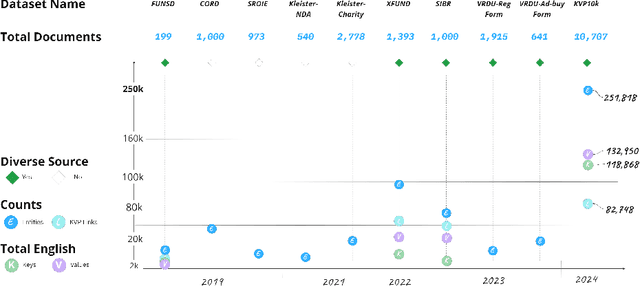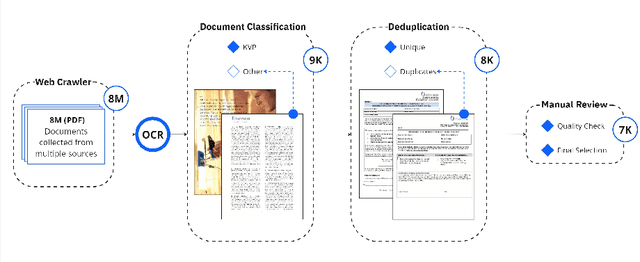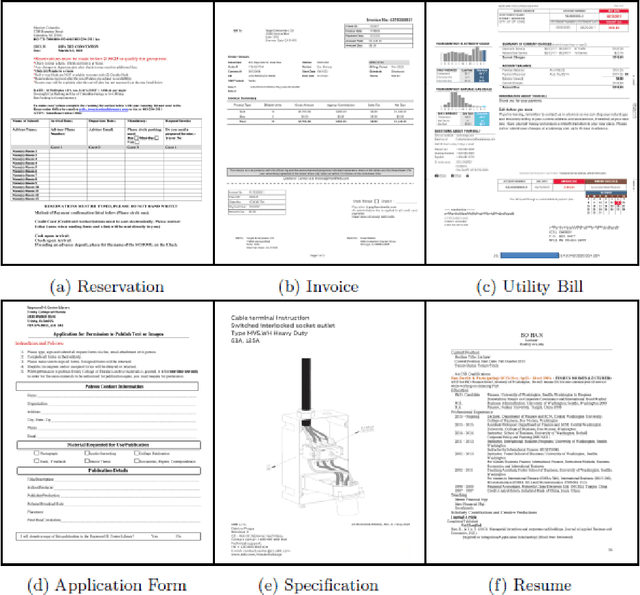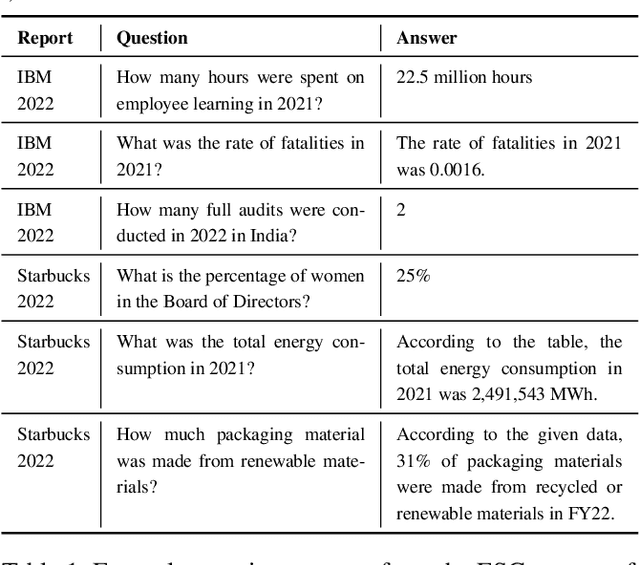Ahmed Nassar
IBM Research
MarkushGrapher: Joint Visual and Textual Recognition of Markush Structures
Mar 20, 2025Abstract:The automated analysis of chemical literature holds promise to accelerate discovery in fields such as material science and drug development. In particular, search capabilities for chemical structures and Markush structures (chemical structure templates) within patent documents are valuable, e.g., for prior-art search. Advancements have been made in the automatic extraction of chemical structures from text and images, yet the Markush structures remain largely unexplored due to their complex multi-modal nature. In this work, we present MarkushGrapher, a multi-modal approach for recognizing Markush structures in documents. Our method jointly encodes text, image, and layout information through a Vision-Text-Layout encoder and an Optical Chemical Structure Recognition vision encoder. These representations are merged and used to auto-regressively generate a sequential graph representation of the Markush structure along with a table defining its variable groups. To overcome the lack of real-world training data, we propose a synthetic data generation pipeline that produces a wide range of realistic Markush structures. Additionally, we present M2S, the first annotated benchmark of real-world Markush structures, to advance research on this challenging task. Extensive experiments demonstrate that our approach outperforms state-of-the-art chemistry-specific and general-purpose vision-language models in most evaluation settings. Code, models, and datasets will be available.
SmolDocling: An ultra-compact vision-language model for end-to-end multi-modal document conversion
Mar 14, 2025Abstract:We introduce SmolDocling, an ultra-compact vision-language model targeting end-to-end document conversion. Our model comprehensively processes entire pages by generating DocTags, a new universal markup format that captures all page elements in their full context with location. Unlike existing approaches that rely on large foundational models, or ensemble solutions that rely on handcrafted pipelines of multiple specialized models, SmolDocling offers an end-to-end conversion for accurately capturing content, structure and spatial location of document elements in a 256M parameters vision-language model. SmolDocling exhibits robust performance in correctly reproducing document features such as code listings, tables, equations, charts, lists, and more across a diverse range of document types including business documents, academic papers, technical reports, patents, and forms -- significantly extending beyond the commonly observed focus on scientific papers. Additionally, we contribute novel publicly sourced datasets for charts, tables, equations, and code recognition. Experimental results demonstrate that SmolDocling competes with other Vision Language Models that are up to 27 times larger in size, while reducing computational requirements substantially. The model is currently available, datasets will be publicly available soon.
Docling: An Efficient Open-Source Toolkit for AI-driven Document Conversion
Jan 27, 2025



Abstract:We introduce Docling, an easy-to-use, self-contained, MIT-licensed, open-source toolkit for document conversion, that can parse several types of popular document formats into a unified, richly structured representation. It is powered by state-of-the-art specialized AI models for layout analysis (DocLayNet) and table structure recognition (TableFormer), and runs efficiently on commodity hardware in a small resource budget. Docling is released as a Python package and can be used as a Python API or as a CLI tool. Docling's modular architecture and efficient document representation make it easy to implement extensions, new features, models, and customizations. Docling has been already integrated in other popular open-source frameworks (e.g., LangChain, LlamaIndex, spaCy), making it a natural fit for the processing of documents and the development of high-end applications. The open-source community has fully engaged in using, promoting, and developing for Docling, which gathered 10k stars on GitHub in less than a month and was reported as the No. 1 trending repository in GitHub worldwide in November 2024.
Docling Technical Report
Aug 19, 2024



Abstract:This technical report introduces Docling, an easy to use, self-contained, MIT-licensed open-source package for PDF document conversion. It is powered by state-of-the-art specialized AI models for layout analysis (DocLayNet) and table structure recognition (TableFormer), and runs efficiently on commodity hardware in a small resource budget. The code interface allows for easy extensibility and addition of new features and models.
KVP10k : A Comprehensive Dataset for Key-Value Pair Extraction in Business Documents
May 01, 2024



Abstract:In recent years, the challenge of extracting information from business documents has emerged as a critical task, finding applications across numerous domains. This effort has attracted substantial interest from both industry and academy, highlighting its significance in the current technological landscape. Most datasets in this area are primarily focused on Key Information Extraction (KIE), where the extraction process revolves around extracting information using a specific, predefined set of keys. Unlike most existing datasets and benchmarks, our focus is on discovering key-value pairs (KVPs) without relying on predefined keys, navigating through an array of diverse templates and complex layouts. This task presents unique challenges, primarily due to the absence of comprehensive datasets and benchmarks tailored for non-predetermined KVP extraction. To address this gap, we introduce KVP10k , a new dataset and benchmark specifically designed for KVP extraction. The dataset contains 10707 richly annotated images. In our benchmark, we also introduce a new challenging task that combines elements of KIE as well as KVP in a single task. KVP10k sets itself apart with its extensive diversity in data and richly detailed annotations, paving the way for advancements in the field of information extraction from complex business documents.
ESG Accountability Made Easy: DocQA at Your Service
Nov 30, 2023

Abstract:We present Deep Search DocQA. This application enables information extraction from documents via a question-answering conversational assistant. The system integrates several technologies from different AI disciplines consisting of document conversion to machine-readable format (via computer vision), finding relevant data (via natural language processing), and formulating an eloquent response (via large language models). Users can explore over 10,000 Environmental, Social, and Governance (ESG) disclosure reports from over 2000 corporations. The Deep Search platform can be accessed at: https://ds4sd.github.io.
MolGrapher: Graph-based Visual Recognition of Chemical Structures
Aug 23, 2023Abstract:The automatic analysis of chemical literature has immense potential to accelerate the discovery of new materials and drugs. Much of the critical information in patent documents and scientific articles is contained in figures, depicting the molecule structures. However, automatically parsing the exact chemical structure is a formidable challenge, due to the amount of detailed information, the diversity of drawing styles, and the need for training data. In this work, we introduce MolGrapher to recognize chemical structures visually. First, a deep keypoint detector detects the atoms. Second, we treat all candidate atoms and bonds as nodes and put them in a graph. This construct allows a natural graph representation of the molecule. Last, we classify atom and bond nodes in the graph with a Graph Neural Network. To address the lack of real training data, we propose a synthetic data generation pipeline producing diverse and realistic results. In addition, we introduce a large-scale benchmark of annotated real molecule images, USPTO-30K, to spur research on this critical topic. Extensive experiments on five datasets show that our approach significantly outperforms classical and learning-based methods in most settings. Code, models, and datasets are available.
ICDAR 2023 Competition on Robust Layout Segmentation in Corporate Documents
May 24, 2023Abstract:Transforming documents into machine-processable representations is a challenging task due to their complex structures and variability in formats. Recovering the layout structure and content from PDF files or scanned material has remained a key problem for decades. ICDAR has a long tradition in hosting competitions to benchmark the state-of-the-art and encourage the development of novel solutions to document layout understanding. In this report, we present the results of our \textit{ICDAR 2023 Competition on Robust Layout Segmentation in Corporate Documents}, which posed the challenge to accurately segment the page layout in a broad range of document styles and domains, including corporate reports, technical literature and patents. To raise the bar over previous competitions, we engineered a hard competition dataset and proposed the recent DocLayNet dataset for training. We recorded 45 team registrations and received official submissions from 21 teams. In the presented solutions, we recognize interesting combinations of recent computer vision models, data augmentation strategies and ensemble methods to achieve remarkable accuracy in the task we posed. A clear trend towards adoption of vision-transformer based methods is evident. The results demonstrate substantial progress towards achieving robust and highly generalizing methods for document layout understanding.
Optimized Table Tokenization for Table Structure Recognition
May 05, 2023Abstract:Extracting tables from documents is a crucial task in any document conversion pipeline. Recently, transformer-based models have demonstrated that table-structure can be recognized with impressive accuracy using Image-to-Markup-Sequence (Im2Seq) approaches. Taking only the image of a table, such models predict a sequence of tokens (e.g. in HTML, LaTeX) which represent the structure of the table. Since the token representation of the table structure has a significant impact on the accuracy and run-time performance of any Im2Seq model, we investigate in this paper how table-structure representation can be optimised. We propose a new, optimised table-structure language (OTSL) with a minimized vocabulary and specific rules. The benefits of OTSL are that it reduces the number of tokens to 5 (HTML needs 28+) and shortens the sequence length to half of HTML on average. Consequently, model accuracy improves significantly, inference time is halved compared to HTML-based models, and the predicted table structures are always syntactically correct. This in turn eliminates most post-processing needs.
Multilevel sentiment analysis in arabic
May 24, 2022



Abstract:In this study, we aimed to improve the performance results of Arabic sentiment analysis. This can be achieved by investigating the most successful machine learning method and the most useful feature vector to classify sentiments in both term and document levels into two (positive or negative) categories. Moreover, specification of one polarity degree for the term that has more than one is investigated. Also to handle the negations and intensifications, some rules are developed. According to the obtained results, Artificial Neural Network classifier is nominated as the best classifier in both term and document level sentiment analysis (SA) for Arabic Language. Furthermore, the average F-score achieved in the term level SA for both positive and negative testing classes is 0.92. In the document level SA, the average F-score for positive testing classes is 0.94, while for negative classes is 0.93.
 Add to Chrome
Add to Chrome Add to Firefox
Add to Firefox Add to Edge
Add to Edge